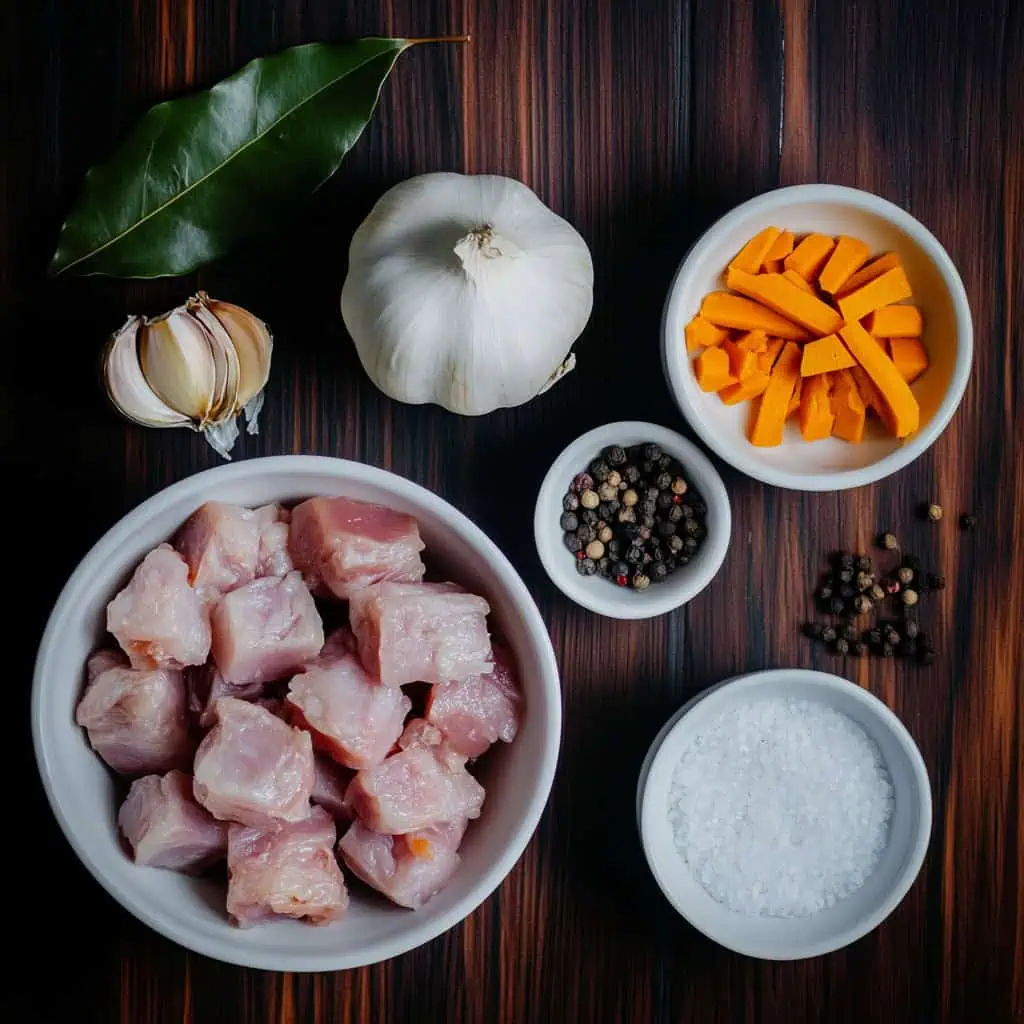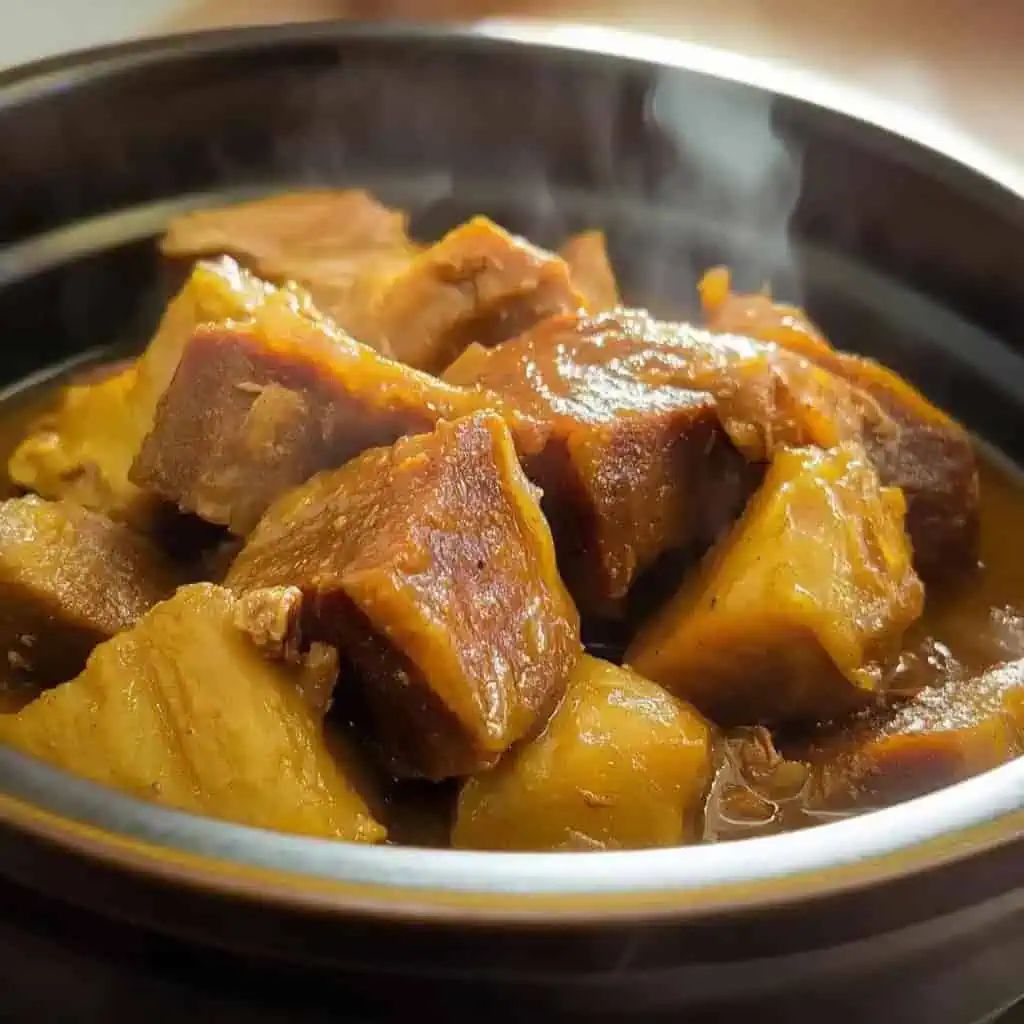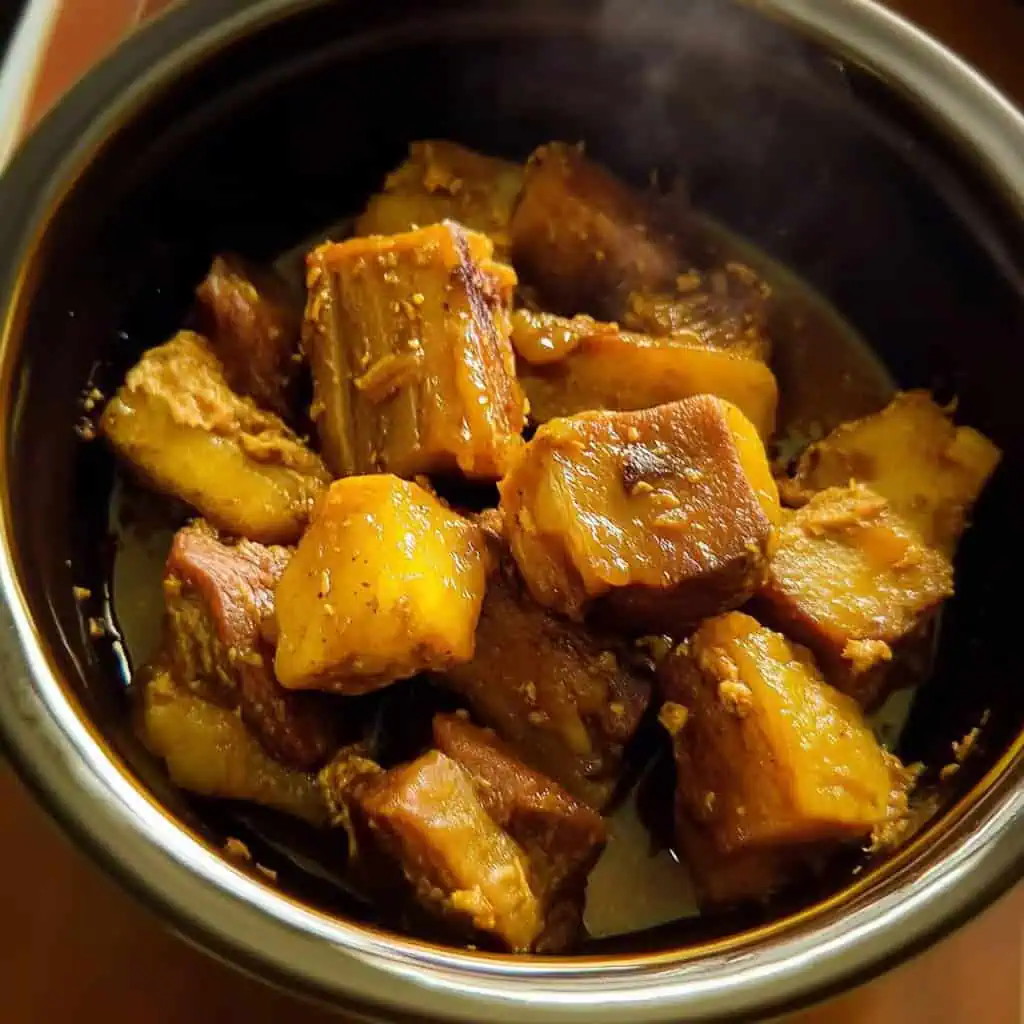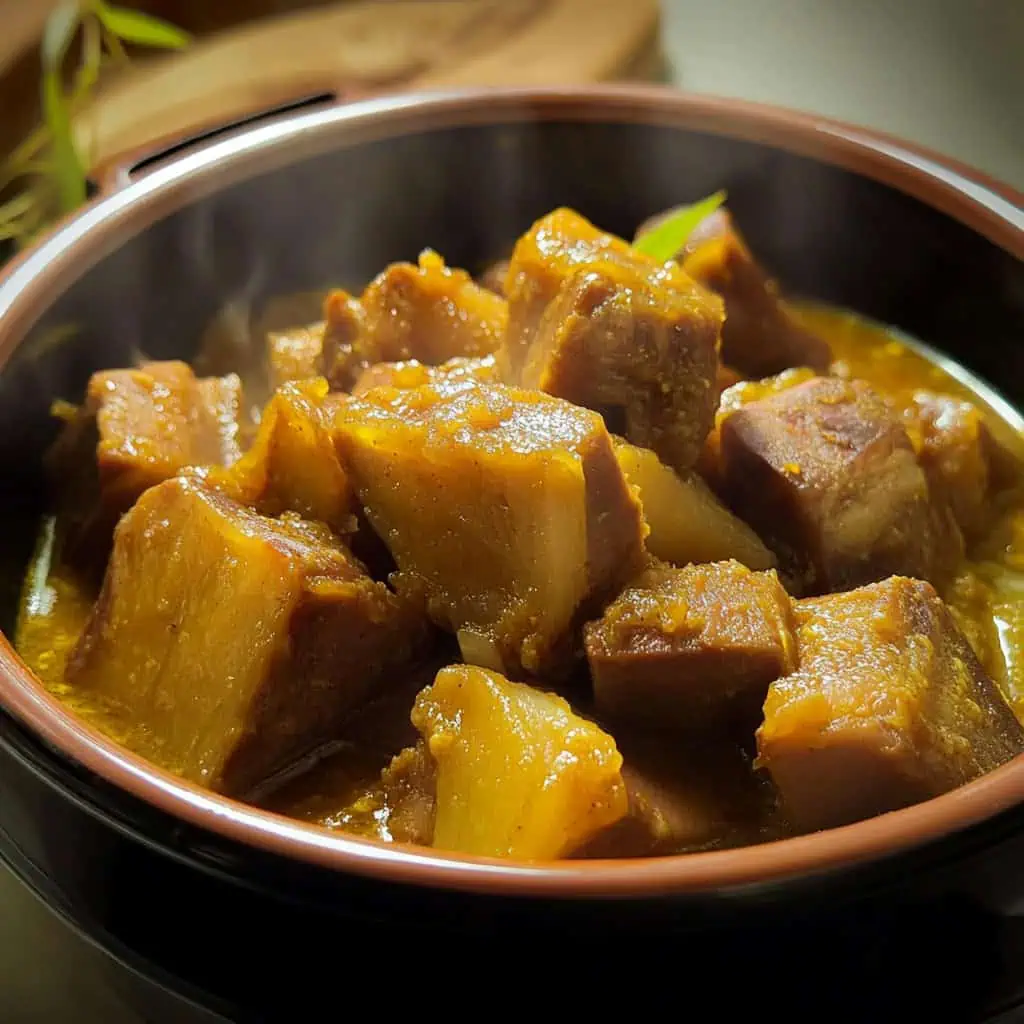Let me introduce you to one of my favorite takes on Filipino adobo - the Adobong Dilaw.
If you think regular adobo is good (and it is!), wait until you try this golden beauty from Taal, Batangas. It's got all that vinegary, garlicky goodness you love. But here's the twist: we're throwing in fresh turmeric root that turns everything into this stunning yellow color and adds this amazing earthy kick.
Don't worry if you've never cooked with turmeric before, this recipe is pretty forgiving and the payoff is totally worth it. Plus, that turmeric isn't just for show. It's actually super good for you!
Cultural Notes
Adobong Dilaw originated from Taal, Batangas, and is distinct from the more common dark adobo. The yellow color from turmeric represents prosperity in Filipino culture, making this dish popular during celebrations.
Jump to:

Why You'll Love This Recipe
- Rich golden color from fresh turmeric (luyang dilaw)
- Perfect balance of savory and tangy flavors
- Fork-tender meat that melts in your mouth
- Healthier version with anti-inflammatory turmeric
- One-pot meal perfect for busy weeknights
- Gets better the next day as flavors develop
- Freezer-friendly for meal prep
Ingredients
This carefully balanced blend combines fatty pork belly for richness and tenderness with the bright acidity of vinegar to cut through the fat. Fresh turmeric adds both golden color and earthy, peppery notes with anti-inflammatory benefits.
Aromatics like garlic, onion, and bay leaves create a deep flavor foundation, while the simple addition of water allows everything to meld into a perfectly balanced sauce that's both comforting and complex.

- 3 pounds pork belly, cut into 2-inch cubes
- 1 tablespoon canola oil
- 1 medium onion, peeled and chopped
- 1 whole head garlic, peeled and minced
- 1 thumb-size fresh turmeric, peeled and julienned
- 1 cup white vinegar
- 1½ cups water
- 2 bay leaves
- Salt and pepper to taste
Equipment
- Large heavy-bottom pot or Dutch oven - Essential for even heat distribution and slow braising, preventing scorching of the sauce
- Sharp knife - For cleanly cutting the pork belly into uniform pieces
- Cutting board - Provides a stable surface for preparing ingredients
- Measuring cups and spoons - For accurate ingredient measurements
- Wooden spoon - Gentler on cookware than metal utensils and perfect for stirring
- Meat thermometer (optional) - To ensure meat is thoroughly cooked to a safe temperature
- Garlic crusher - Makes mincing garlic faster and releases more flavor

How To Make
- Pat your pork belly dry with paper towels and cut it into 2-inch cubes. Chop your onion, mince the garlic, and cut the fresh turmeric into thin strips.
- Heat canola oil in a large pot over medium heat. Add your chopped onions, garlic, and turmeric. Cook until the onions become translucent and aromatics are fragrant, about 3-4 minutes.
- Add your pork belly cubes and cook until lightly browned and beginning to turn yellow from the turmeric, about 5-7 minutes. Avoid overcrowding the pot to allow proper browning.
- Pour in the vinegar and bring to a boil. Important: do not stir for the next 4-5 minutes to mellow out the strong vinegar taste.
- Add the water and bay leaves. Return to a boil, then reduce heat to low. Cover and simmer for about 50 minutes to 1 hour, until the pork is fork-tender.
- Check meat tenderness by piercing with a fork – it should slide through easily. If not tender enough, continue cooking in 10-minute increments until perfect. Once tender, taste the sauce and adjust salt and pepper as needed. For a thicker sauce, continue cooking uncovered for 5-10 more minutes.
- Allow your adobo to rest for 10 minutes before serving for enhanced flavor. Serve hot with steamed rice, garnished with fried garlic if desired.

Tips from Lola's Kitchen
- Use high-quality vinegar - Native sukang Iloko will give you the most authentic flavor profile
- Practice the "no-stir" technique - When adding vinegar, resist stirring for 4-5 minutes to properly cook out the harsh acidity
- Consider a clay pot - Using a traditional palayok infuses a subtle earthy flavor that enhances the dish
- Add whole peppercorns - Toss in 1 tablespoon of whole black peppercorns for additional depth and aroma
- Rest before serving - Let your finished adobo sit for at least 30 minutes before serving to allow flavors to fully meld
- Yellow stains happen - Turmeric can stain cutting boards and wooden spoons; use dedicated tools or stainless steel when possible
Substitutions
- Pork Belly: Substitute with chicken thighs, pork shoulder, or beef chuck for different variations
- Fresh Turmeric: If unavailable, use 1 tablespoon of ground turmeric (though the flavor won't be as complex)
- White Vinegar: Apple cider vinegar or coconut vinegar work well as alternatives
- Canola Oil: Substitute with coconut oil or vegetable oil
- Fresh Garlic: In a pinch, use 2 tablespoons of garlic powder, though fresh is strongly preferred
Troubleshooting
Meat too tough?
- Cook longer on lower heat for more tenderness
- Check if meat pieces are cut too large; smaller pieces cook more thoroughly
- Make sure your pot maintains a gentle simmer throughout cooking
Sauce too sour?
- Add a pinch of sugar or a teaspoon of honey to balance acidity
- Cook uncovered longer to reduce the vinegar intensity
- Add a bit more water to dilute the sourness
Color not yellow enough?
- Add more fresh turmeric for a deeper golden hue
- Ensure your turmeric is fresh with vibrant color
- Allow more time for the turmeric to infuse during cooking
Sauce too thin?
- Simmer uncovered for 10-15 additional minutes
- Remove some sauce, mix with 1 teaspoon cornstarch, return to pot and simmer
Sauce too thick?
- Add water in small increments until desired consistency is reached
Storage & Reheating
Storage:
- Refrigerator: Store in an airtight container for 3-4 days
- Freezer: Freeze in portion-sized containers for up to 3 months
- Room Temperature: Not recommended for food safety reasons
Reheating:
- Stovetop: Place in a pot over low heat with a splash of water, stirring occasionally until heated through (about 5-7 minutes)
- Microwave: Heat in a microwave-safe container for 2-3 minutes, stirring halfway through
- Safety: Always reheat to an internal temperature of 165°F (74°C)
Pro Tip: This dish often tastes better the next day as flavors continue to develop overnight.

FAQ
Can I make this ahead for a party?
Absolutely! In fact, Adobong Dilaw tastes even better the next day as the flavors have time to fully develop. Make it 1-2 days ahead and reheat gently before serving.
Why doesn't this recipe use soy sauce like regular adobo?
This regional version from Taal, Batangas traditionally relies on salt and turmeric for flavor rather than soy sauce, resulting in the distinctive yellow color and cleaner taste profile.
How do I know when the pork is properly cooked?
The pork should be fork-tender, meaning a fork easily pierces and slightly pulls apart the meat. For food safety, the internal temperature should reach at least 145°F (63°C).
Can I use lean meat instead of pork belly?
Yes, you can use leaner cuts like pork loin or tenderloin, but the cooking time will need to be reduced to prevent dryness. The dish won't be as rich without the fat from pork belly.
Is turmeric powder an acceptable substitute for fresh turmeric?
While you can substitute 1 tablespoon of turmeric powder, fresh turmeric provides a brighter color and more complex, aromatic flavor. The powder works in a pinch but expect some difference in the final result.
Can I make this dish spicy?
Absolutely! Add 3-4 bird's eye chilies (siling labuyo) during cooking for a spicy kick that complements the tangy flavors wonderfully.
How can I make this dish healthier?
Use pork shoulder instead of belly to reduce fat content, and add vegetables like carrots, potatoes, or bell peppers during the last 20 minutes of cooking for added nutrition.
Will turmeric stain my cookware?
Turmeric can temporarily stain some plastics and lighter-colored cookware. Using stainless steel, cast iron, or ceramic cookware minimizes staining concerns.
Related
Looking for other recipes like this? Try these:

Adobong Dilaw (Filipino Yellow Turmeric Adobo)
Equipment
- Large heavy-bottom pot or Dutch oven (para sa matagal na pagluluto)
- Sharp knife for cutting meat (pamputol ng karne)
- Cutting board (Sangkalan)
- Measuring cups and spoons (Panukat)
- Wooden spoon (panghalo)
- Meat thermometer (optional, para sa tamang temperatura)
- Garlic crusher (pangpisa ng bawang)
Ingredients
- 3 pounds pork belly liempo, cut into 2-inch cubes
- 1 tablespoon canola oil
- 1 medium onion sibuyas, peeled and chopped
- 1 whole head garlic bawang, peeled and minced
- 1 thumb-size fresh turmeric luyang dilaw, peeled and julienned
- 1 cup white vinegar suka
- 1½ cups water tubig
- 2 bay leaves dahon ng laurel
- Salt and pepper to taste asin at paminta
Instructions
- First, pat your pork belly dry with paper towels and cut it into 2-inch cubes. Chop your onion, mince the garlic, and cut the fresh turmeric into thin strips.
- Heat canola oil in a large pot over medium heat. Add your chopped onions, garlic, and turmeric. Cook them until the onions become clear and you can smell the aromatics, about 3-4 minutes.
- Put in your pork belly cubes and cook them until they're lightly browned and start turning yellow from the turmeric. This takes about 5-7 minutes. Make sure not to overcrowd the pot so the meat can brown properly.
- Pour in the vinegar and let it come to a boil. Here's an important tip: don't stir for the next 4-5 minutes. This helps mellow out the strong vinegar taste.
- Add the water and bay leaves. Let it come back to a boil, then turn the heat to low. Cover the pot and let it cook slowly for about 50 minutes to 1 hour. You'll know the pork is ready when you can easily pierce it with a fork.
- Check if the meat is tender enough by poking it with a fork – it should slide right through. If it's not tender yet, keep cooking in 10-minute chunks until it's perfect. Once it's tender, taste the sauce and add salt and pepper until it tastes right to you. If you want thicker sauce, just cook it uncovered for 5-10 more minutes.
- Let your adobo rest for 10 minutes before serving. This makes it taste even better. Serve it hot with rice, and if you like, sprinkle some fried garlic on top.
- Store any leftovers in a clean container in the fridge once they've cooled down completely. It'll stay good for 3-4 days, and many people say it tastes even better the next day!
Tips from Lola's Kitchen
- Use native sukang Iloko for authentic flavor
- Never stir when vinegar is first added to maintain acidity
- Cook in palayok (clay pot) for traditional earthy taste
- Add whole peppercorns for extra aromatics
- Let rest for 30 minutes before serving for better flavor absorption
Nutrition
The Story Behind Adobong Dilaw
Growing up in the sun-drenched provinces of the Philippines, I discovered that adobo isn't just a dish - it's a vibrant tapestry of regional variations, each telling its own unique story. Among these variations, Adobong Dilaw stands as a golden testament to the culinary ingenuity of Taal, Batangas, where this distinctive version was born.
While the classic dark adobo reigns supreme across the archipelago, this yellow-hued cousin carved its own niche in Filipino cuisine, particularly in the Batangas region and parts of Visayas and Mindanao. What sets it apart is the star ingredient - luyang dilaw, or fresh turmeric root, which not only imparts a striking golden color but also introduces subtle earthy notes and peppery undertones that dance harmoniously with the traditional adobo profile.
The origins of this dish speak to our ancestors' wisdom in combining flavor with function. Long before turmeric became a global superfood, Filipino cooks were already harnessing its anti-inflammatory properties and distinct taste in their cooking. In Taal's heritage homes, the marriage of turmeric with the classic adobo technique created something truly special - a dish that was both medicinal and memorably delicious.
The significance of Adobong Dilaw extends beyond its taste. In Filipino culture, the color yellow symbolizes prosperity and good fortune, making this dish a popular choice during celebrations and family gatherings. The recipe has been passed down through generations, with each family adding their own subtle tweaks while maintaining the core elements that make it uniquely Batangueño.
This heritage recipe showcases the beautiful simplicity of Filipino cooking - how a single ingredient can transform a familiar dish into something extraordinary. Today, as more people discover the health benefits of turmeric, Adobong Dilaw is experiencing a renaissance, finding its way onto modern Filipino tables while carrying the rich history and traditions of its origins. It's a delicious reminder that sometimes, the most remarkable dishes come from simply reimagining the classics with ingredients that have been growing in our backyards all along.
What makes this version particularly special is how it demonstrates the Filipino talent for adaptation. While maintaining the soul of traditional adobo - that perfect balance of sour and savory - it introduces an element that makes it not just a meal, but a celebration of regional Filipino cuisine's diversity. Every bite tells the story of Taal's culinary heritage, of family gatherings around the dinner table, and of the endless possibilities that arise when tradition meets innovation in the Filipino kitchen.










Comments
No Comments